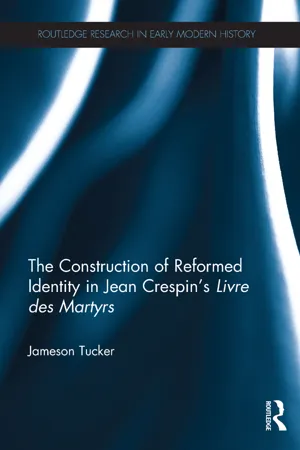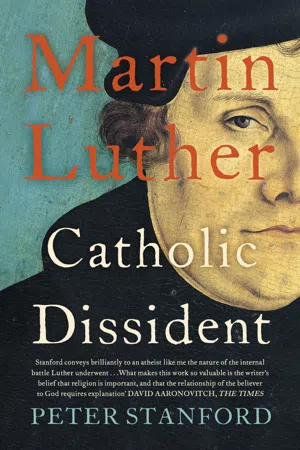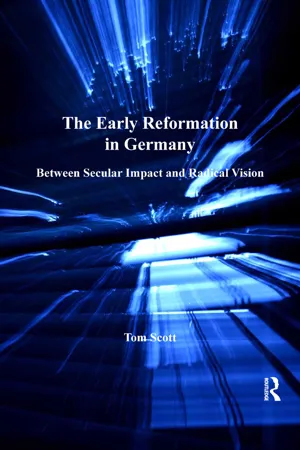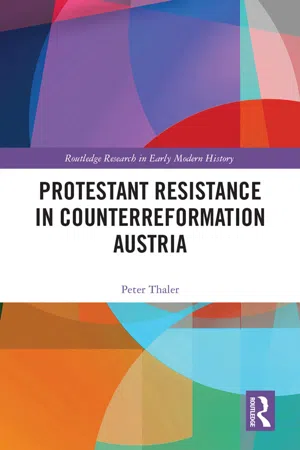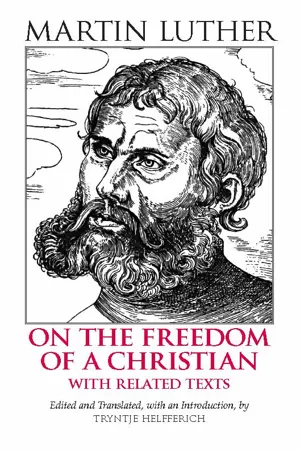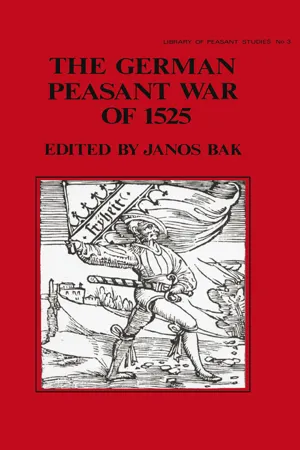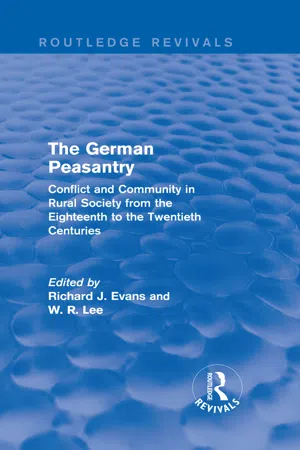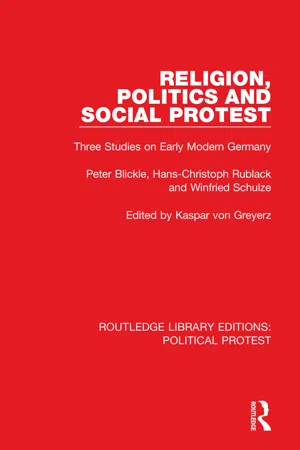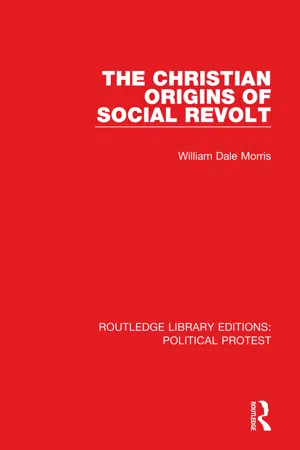History
German Peasants War
The German Peasants' War was a widespread popular revolt that took place in the Holy Roman Empire between 1524 and 1525. It was sparked by social and economic grievances among the peasantry, and it sought to address issues such as serfdom and oppressive taxation. The conflict ultimately ended in defeat for the peasant forces, resulting in harsh repression and the reinforcement of feudal authority.
Written by Perlego with AI-assistance
Related key terms
11 Key excerpts on "German Peasants War"
- eBook - ePub
The Construction of Reformed Identity in Jean Crespin's Livre des Martyrs
All The True Christians
- Jameson Tucker(Author)
- 2017(Publication Date)
- Routledge(Publisher)
5 The German Peasants’ WarThe German Peasants’ War of 1524–26 had been a subject of controversy, particularly amongst Protestants, from its beginning. It was perhaps the greatest upheaval of the century, involving an estimated 300,000 people and 100,000 deaths across the southern areas of the Holy Roman Empire, and briefly appeared to present a serious threat to the existing social and political orders.1 Peasant grievances included the tithe, and many of the peasant bands attacked monasteries and clerical landlords, giving the uprising an anti-clerical character. The stated aims of the peasant bands helped to give the uprising a Protestant appearance. The Twelve Articles of the peasant bands embraced a principle of appeal to the Bible that suggested an inspiration from the Reformation, and as James Stayer has noted, a great many of the peasants themselves ‘thought of the enterprise as their contribution to the Reformation’.2On the Peasants’ War, Crespin was joining a controversy that had already been in progress for decades. The question of the role played by the Reformation in sparking the unrest had indeed been immediately raised by Catholic controversialists such as Cochlaeus, and is still a topic of academic debate.3 Luther’s Admonition to Peace - eBook - ePub
Martin Luther
Catholic Dissident
- Peter Stanford(Author)
- 2017(Publication Date)
- Hodder Faith(Publisher)
Some 25,000 copies of the ‘Twelve Articles’ were printed and circulated around Germany. By the time they appeared, the Peasants’ War was underway, from Alsace in the west to Meissen in the east, though the majority of the conflict occurred in the south and west. There was little by way of organised leadership among the rebels, little co-ordination, and a variety of motivations for taking up arms. Some were local, some economic, some social, some religious. Some of those who rebelled were traditional Catholics, some were ‘new’ Lutherans, some from other reform-minded offshoots. Zwingli offered his support to the rising from the Swiss cantons he now controlled. And, despite it being known to history as the Peasants’ War, this was by no means a straightforward class conflict.The immediate spark for the conflagration is as hard to identify as anything else about this rising. Some point to a ‘Knights’ Revolt’ in 1522 and 1523 in the Rhineland in the west, where groups of lesser nobility vented their dislike at losing out in the pecking order to the new merchant/burgher class in the towns. They complained that their ancestral lands were lost, their military role usurped, and that the money economy in towns replacing the existing feudal system was ruining them. This revolt was in many senses an essentially conservative and backward-looking uprising, but it may have fanned the flames of wider peasant unrest.Another potential starting point was the demand by a Countess Helena Lupfen in the autumn of 1524, made on her ancestral lands in Stühlingen in the Black Forest region, that ‘her’ peasants collect snail shells. She was evidently fond of winding thread around such shells and wanted a new supply. For the peasants, however, exhausted by successive failures of the harvest, the countess’s imperious and frivolous order was the last straw. They rose up in fury and their defiance quickly spread throughout southwest Germany, merging with other simmering local issues. At Kempten in Swabia, for example, fighting broke out over a dispute concerning its status as an imperial free town and the role of the local monastery.By the spring of 1525, the Peasants’ War was at its height. Perhaps the most notorious episode came on 17 April 1525. Count Ludwig von Helfenstein, a relative by marriage of Emperor Charles, and a group of up to seventy nobles were captured by a ‘peasants’ army’ under Jacklein Rohrbach near Weinsberg. They were made to run the gauntlet and massacred. Their relatives swore revenge. - eBook - ePub
The Early Reformation in Germany
Between Secular Impact and Radical Vision
- Tom Scott(Author)
- 2016(Publication Date)
- Routledge(Publisher)
The Revolution of 1525. The German Peasants’ War from a New Perspective, trans. Thomas A. Brady, Jr and H. C. Erik Midelfort (Baltimore, MD/London, 1981). Subsequent revisions make the use of the most recent German version preferable.3 Rodney Hilton, ‘Social concepts in the English Rising of 1381’, in idem, Class Conflict and the Crisis of Feudalism. Essays in Medieval Social History (London/Ronceverte, WV, 1985), p. 216.Among the urban population, in many cases the poorer groups who had largely been denied burgher’s rights, they [the rural rebels] mostly found their allies, who opened the gates to the approaching peasant armies, so that we can for that reason no longer speak of purely peasant uprisings.44 Horst Gerlach, Der englische Bauernaufstand von 1381 und der deutsche Bauernkrieg. Ein Vergleich (Meisenheim am Glan, 1969), p. 206.A comparison of the two rebellions gains added piquancy since the English Peasants’ Revolt can hardly be accused of pre-empting or appropriating the evangelically legitimated slogans of 1525 which stemmed from the Reformers’ attack on Catholic hierarchy and tradition. To do full justice to such a wide-ranging comparison, however, would be to exceed the acceptable limits of an essay. Rather, the present study focuses on one issue which goes to the heart of any understanding of ideology in the genesis and dissemination of popular protest, namely whether in England in 1381 and Germany in 1525 the rebels in town and country made common cause out of principled solidarity, or instead co-operated in temporary and tactical alliances.55 For the German Peasants’ War this issue had been addressed by Tom Scott, ‘Reformation and Peasants’ War in Waldshut and environs: A structural analysis’, part 1, Archiv für Reformationsgeschichte, 69 (1978), pp. 82-102; part 2, ibid., 70 (1979), pp. 140-69. Reprinted in idem, Town, Country, and Regions in Reformation Germany - eBook - ePub
- Bob Scribner, Gerhard Benecke, Bob Scribner, Gerhard Benecke(Authors)
- 2021(Publication Date)
- Routledge(Publisher)
genossenschaftlich but not democratic aims was as removed from the political preoccupations of Germany between the two world wars as he hoped (Franz, 1933: 287-8; Vahle, 1972: 265-6). Zimmerman and Franz do not stand alone in their political engagement. Historians have tended to react with intensity to the Peasant War, and in so doing they have often carried their politics with them. Perhaps the ultimate testimony a historian pays to his emotional involvement in an event he is interpreting is to ask, ‘Could it have been otherwise?’ - and few historians of the Peasant War have been able to refrain from putting that question. Historians of all political complexions have loaded the sins and hopes of German history on to the Peasant War. The conservative fears of Ranke, the revolutionary disappointments of Engels and the liberal sympathies of Lamprecht all found expression in their treatments of the Peasant War; each man attributed to the event an exemplary character and gave it a pivotal position in German history. As we will show, twentieth-century scholars who have contributed to the subject have often done the same, sometimes more circumspectly.The Peasant War, then, is an event which has long been considered important and controversial. Many talented historians with different views of the historical process and contrasting ideals have devoted their energies to it. One might expect the results to have been a wide-ranging and fruitful debate which would have, if it did not establish a stable consensus, at least provided a constellation of useful hypotheses. The infusion of political engagement can energise and sharpen more than it muddles historical investigation, as the literature on the French Revolution illustrates. But the framework within which the historical debate on the Peasant War has taken place has been narrow. Vigorous polemic has concealed common assumptions which today look either untenable or unprofitable, and which have inhibited historians from seeing or pursuing other approaches.Among nineteenth-century historians whose interpretations in other respects diverged from one another, it was a common assumption that the Peasant War was directed towards national unification. In the twentieth century this assumption has been sometimes doubted and sometimes qualified, as in the current debate among Marxist scholars as to whether the insurrectionaries aimed consciously at national unification or were directed unconsciously towards that goal (Töpfer, 1963; Zschäbitz, 1964). But the most influential interpretations of the Peasant War in the twentieth century have continued to argue that the insurrectionaries were fighting for a remodelled Reich - Peter Thaler(Author)
- 2020(Publication Date)
- Routledge(Publisher)
(Berlin, 1962); Gordon Rupp, “‘True History’: Martin Luther and Thomas Müntzer,” in History, Society and the Churches: Essays in Honour of Owen Chadwick, ed. Derek Beales and Geoffrey Best (Cambridge, England, 1985), 77–87; and Harry Loewen, Luther and the Radicals: Another Look at Some Aspects of the Struggle between Luther and Radical Reformers (Waterloo, ON, 1974). For a general discussion of Luther’s role during the Peasants’ War, see also Paul Althaus, Luthers Haltung im Bauernkrieg (Tübingen, 1952); Robert N. Crossley, Luther and the Peasants War: Luther’s Actions and Reactions (New York, 1974); and Martin Greschat, “Luthers Haltung im Bauernkrieg,” Archiv für Reformationsgeschichte 65 (1965): 31–47. 10. Strictly speaking, the Great Peasants’ War culminated during the first half of 1525 but included both a southwestern prelude in 1524 and an Alpine aftermath extending into 1526. It has been the subject of numerous scholarly investigations. Among still widely used studies, one may list Günther Franz, Der deutsche Bauernkrieg, 12th ed. (Darmstadt, 1984); Horst Buszello, Peter Blickle, and Rudolf Endres, eds., Der deutsche Bauernkrieg 3rd ed. (Paderborn, 1995); Peter Blickle, Der Bauernkrieg: Die Revolution des Gemeinen Mannes, 4th ed. (Munich, 2012); and idem, Die Revolution von 1525, 4th ed. (Munich, 2004); an earlier edition was translated into English as The Revolution of 1525: The German Peasants’ War from a New Perspective (Baltimore, 1981). For an introduction to diverse interpretations in English, see also Bob Scribner and Gerhard Benecke, eds., The German Peasant War of 1525: New Viewpoints (Boston, 1979). 11- eBook - ePub
On the Freedom of a Christian
With Related Texts
- Martin Luther, Tryntje Helfferich(Authors)
- 2013(Publication Date)
- Hackett Publishing Company, Inc.(Publisher)
Letter to the Princes of Saxony, Müntzer was thus bitterly critical of Luther’s discomfort with any alteration of the contemporary hierarchical class society and his unconditional support for the power of the princes. This was, Müntzer argued, a clear sign that Luther was a pure hypocrite, greedy for honors and preferences and willing to prostitute his theology to win the support of the German nobility.After his flight from Allstedt, Müntzer ended up in nearby Mühlhausen, where he was named pastor. There his political, social, and economic egalitarianism, along with his apocalyptic desire to cleanse the world of unbelievers before the last days (and by violence if necessary), would soon push him into supporting and then becoming one of the leaders of a large peasant revolt later known as the German Peasants’ War (1524–1526). Despite its name, this war was not a single conflict, but a series of connected or related popular uprisings that began in 1524, spread like wildfire throughout central Europe, and culminated in a series of battles in May 1525. And just as local conditions differed, so too did the underlying factors driving this war, although one can make some generalizations about the three issues that seem most consequential. First was the enormous pent-up anger over new and ancient feudal dues, rents, and compulsory labor due from the peasantry to the local nobility and territorial princes. The cost of these extractions could amount to a large portion of a family’s income, and did not include the traditional tithes also due to the church. The economic pressure resulting from such fees and taxes was further exacerbated by inflation and the growing rural population, which meant smaller plot sizes for the peasantry, lower wages for workers, and a large increase in the number of landless poor. Second was the frustration and fear caused by the efforts of territorial German princes to strengthen their control over their states. As part of a larger continent-wide trend, rulers in central Europe had recently begun to curtail the legal and political autonomy traditionally practiced by village and town councils within their borders, and even to introduce the hierarchy-friendly Roman law in place of more egalitarian common systems of law. Third was the Reformation. - eBook - ePub
- Janos Bak(Author)
- 2013(Publication Date)
- Routledge(Publisher)
It is also the cause of the many difficulties Marxist historians face when discussing questions of analysis and assessment, which, due to intensive historical research, may suggest corrections of the ‘classical’ position. Additional problems present themselves when the theses of the Peasant War are compared with other relevant statements of Engels, which to a certain extent contradict them. These problems have recently been discussed among the historians of the German Democratic Republic with promising results. 2 Engels drew the outline of the Marxist interpretation of the Reformation in the Peasant War on the basis of a somewhat simplified socio-economic analysis of the period. Compared with the general overview of Marx, this restricted treatment presents a rather narrow and flat view of history. Yet, Marxist-Leninist historians characterize it as an ‘unsurpassed class-analysis’ [ Bensing, 1961: 193 ], and accept it as a foundation for the thesis that the main opposing groups and their religious-political ideas, their ‘ideologies’, were basically defined by economic and social conditions. Hence the Reformation is perceived as a mass movement primarily determined by socio-economic factors and not, as by most other German historians, a process of intellectual and religious conflict and renewal. However, only the Peasant War was called a revolution by Engels. The Peasant War has always been a very popular topic with engaged socialist historians, like August Bebel [ 1876 ], Karl Kautsky [ 1895 ] and Franz Mehring [ 1964 ], who all followed Engels without adding new insights. Soviet historians turned early to the study of the peasant movements in sixteenth century Germany and M. M. Smirin [ 1955 ] placed them in the centre of his research on the period. He too followed the lead of Engels, but also considered the basic statements of Lenin [ 1963 : vol. 15, 43, vol. 35, 93–94 ] relevant to the subject - eBook - ePub
The German Peasantry (Routledge Revivals)
Conflict and Community in Rural Society from the Eighteenth to the Twentieth Centuries
- Richard J. Evans, W. R. Lee(Authors)
- 2015(Publication Date)
- Routledge(Publisher)
Landwirtschaft und Kapitalismus. Zur Entwicklung der ökonomischen und sozialen Verhältnisse in der Magdeburger Börde vom Ausgang des 18. Jahrhunderts bis zum Ende des ersten Weltkrieges (Berlin, 1978); H.-J. Rach and B. Weissei (eds.), Bauer und Landarbeiter im Kapitalismus der Magdeburger Börde (Berlin, 1982).25 . A helpful introduction to the differing interpretations is Bob Scribner and Gerhard Benecke (eds.), The German Peasant War of 1525 —New Viewpoints (London, 1979). Essential works include the renowned studies of F. Engels, Der deutsche Bauernkrieg (Berlin, 1979); and G. Franz, Der deutsche Bauernkrieg (Darmstadt, 1975). See also: D. Sabean, Landbesitz und Gesellschaft am Vorabend des Bauernkrieges (Stuttgart, 1972); R. Wohlfeil, Reformation oder frühbürgerliche Revolution? (Munich, 1972). The anniversary in 1975 also yielded a fresh crop of studies, including: J. Bak (ed.), The German Peasant War (London, 1976); H.-U. Wehler (ed.), Der deutsche Bauernkrieg (Göttingen, 1975); R. Wohlfeil (ed.), Der Bauernkrieg 1524–1526 (Munich, 1975); P. Blickle, Die Revolution von 1525 (Munich, 1975), now available as The Revolution of 1525 (Baltimore, 1981). For a comprehensive review of the newer literature, see Tom Scott, ‘The Peasants’ War: A Historiographical Review’, Historical Journal , 22 (1979), pp. 693–720, and (Part II) pp. 953–74. On the wider problematics of peasant protest, see P. Blickle, ‘Peasant Revolts in the German Empire in the late Middle Ages’, Social History , 4 (1979), pp. 223–40; P. Blickle, et al ., Aufruhr und Empörung. Studien zum bäuerlichen Widerstand im Alten Reich (Munich, 1980); W. Schulze, Bäuerlicher Widerstand und feudale Herrschaft in der frühen Neuzeit - eBook - ePub
A Reformation Life
The European Reformation through the Eyes of Philipp of Hesse
- David M. Whitford(Author)
- 2015(Publication Date)
- Praeger(Publisher)
Their rage erupted and then quickly spread. Why, many asked, should they be working on her behalf in the first place? What good had the count or countess ever done for them? Within just a couple of weeks, their rage had become a widespread phenomenon. Initially, many lords let them march and yell and vent, knowing that the cold weather would eventually force them to return to their homes to seek shelter. Ignoring them seemed to be the best policy. However, as their pleas for help and an alleviation of their plight went unanswered, many decided that the time for action had arrived. At just about that moment, the peasants would find a leader who intermingled their economic claims with apocalyptic pronunciations of God’s wrath. According to the preacher Thomas Müntzer, God was angry with the nobility for their slothful abuse of the peasants. From that moment on, the peasants would not only be fighting for their own futures, they would also become the hammer of God’s fierce judgment.Religious Fervor
In many ways, even if Thomas Müntzer had not become the leader of the Peasants’ War, it would still be impossible to tell the story of the peasants without touching on religion, for they cast many of their pleas in religious terms. This was due, at least in part, to the general ethos of the age, but was also undoubtedly due to the influence of Martin Luther.By 1524, even the most rural and secluded of peasants would have heard of Martin Luther. Many had been concerned about his well-being following the Diet of Worms, when he disappeared from sight for almost a year while being hidden by Frederick the Wise. By 1522 he had returned to Wittenberg unscathed and his popularity increased. It is not hard to understand why peasants might have been drawn to him. He might not have been a farmer-peasant, but people knew he was of low birth. He was a man not unlike themselves, who had defied both pope and emperor and survived. He also seemed to many to be a champion for their cause. The reason they believed he supported them is natural and understandable as much as it is also an exaggeration. There seem to be two causes for the misunderstanding. First, some of the early leaders of the Peasants’ War were anti-Catholic clergy, and nearly everyone identified those who opposed the Catholic Church with Luther. For example, when the peasant army arrived in the small city of Waldhut, the pastor of the main church was in the midst of a controversy with the local bishop. Balthasar Hubmaier had read the arguments (writings) of both Ulrich Zwingli and Martin Luther and came to support the evangelical cause. When the bishop heard of the pastor’s anti-Catholic stand, he attempted to remove Hubmaier. However, Hubmaier was known both as a good and powerful preacher and more importantly, as a caring and kind pastor. The people of Waldhut rose to defend him. As they rose to his cause, he threw his lot in with their cause for social and economic justice. Here, quite concretely, the peasants saw a pro-Lutheran (at least in their minds) pastor supporting their cause. Second, because they could not read, they overestimated and misunderstood Luther’s support for them. - eBook - ePub
Religion, Politics and Social Protest
Three Studies on Early Modern Germany
- Peter Blickle, Hans-Christoph Rublack, Winfried Schulze, Kaspar von Greyerz(Authors)
- 2021(Publication Date)
- Routledge(Publisher)
71 also imposed a heavy burden upon the peasants. For the time being, the theory that there was a correlation between the relative backwardness of the governmental system and the likelihood of revolts allows us to put the German peasant revolts of the period under consideration into a general perspective. Peasant resistance is not merely linked in an abstract way to modes of production on which the feudal system is based, that is, compulsory rent for the use of land. The thesis developed here is more concerned with relating the mode of production to the system of government, thereby encompassing the whole framework of changing conditions which played a part in peasants’ resistance. This includes the momentum created by local traditions and the generally accepted conceptions of liberty and rule.This initial explanation of the causes of the German revolts in terms of the imperial system and the specific conditions of rule in the small territories must be supplemented by the examination of a much more fundamental feature of peasant resistance. I should like to define this as a Verrechtlichung (juridification) of the relationship between subjects, landlords and rulers which was brought about by the increasing importance of conflict resolution by litigation.72 Eighteenth-century imperial lawyers were aware of the significance of the outcome of the Peasants’ War for the emergence of the judicial constitution of the Holy Roman Empire; a more detailed examination of its political repercussions is likely to support this conclusion.73 A comparative study of European peasant resistance reveals that the Peasants’ War resulted not only in the princes’ taking greater precautions against new revolts and in more severe levels of punishment, but also in more opportunities for the peasants to lodge complaints within the framework of the emerging territorial legal system. Similar tendencies related to legal reform can be found neither in Hungary after the Dozsa Uprising of 1514 nor in France after the Gabelle Uprising. In Hungary the peasants’ glebae adscriptio was introduced and their opportunities for making complaints generally curtailed.74 In England, for example, there was no reaction, after Somerset’s failure, to the crisis of 1548-9, even if we take into account the commission of inquiry established to look into the enclosure problem and the long-term improvement in the copy-holder’s right to sue.75This argument about the ‘juridification’ of social conflicts in the Holy Roman Empire can draw upon a wide range of empirical evidence. Only a few aspects can be discussed here. First, the subjects’ right to sue their princes was definitively secured by the Supreme Court ruling of 1555.76 Secondly, the establishment of imperial commissions indicates that there was a trend towards diverting impending conflicts into forms of political resolution.77 Thirdly, the clearest evidence of the emergence of ‘juridification’ is provided by the numerous law suits lodged by the peasants in the territorial and imperial courts. There were cases which were pending for generations. During this period there was hardly a revolt which did not have a parallel court case – indeed, the opportunities for resolving conflicts by litigation largely determined the tactics of the peasants’ resistance. Finally, a special kind of literature on feudal rights provides evidence for the process of ‘juridification’. Apart from literature on sedition, which was clearly more practically oriented than its French and English counterparts,78 there are numerous essays on peasant dues, legal positions and services. These essays highlight the issues on which communities and landlords came into conflict.79 Reference is continually made to the numerous court cases dealing with disputed services and dues, but the concept of ‘legitimate resistance’ against overburdening by the landlords also emerges clearly. The saevitia dominorum becomes a collective term for abuses by the landlords or princes and establishes grounds for criticism. The subjects had a precisely defined range of means of legal recourse against this saevitia, known as the remedia juris. 80 - eBook - ePub
- William Dale Morris(Author)
- 2021(Publication Date)
- Routledge(Publisher)
(The Peasant War in Germany , Engels, p. 42.)Luther and the Peasants
Martin Luther, with his vague declaration of human liberty and German brotherhood, found adherents both among the peasantry and the middle class; though this uneasy unity quickly vanished when the peasants took violent measures to carry into effect what they held to be the implications of Luther’s teachings.The Edict of Worms (1521) had denounced Luther as an opponent of law and a breeder of sedition, and there had been some justification for this view since the early Luther had not hesitated to preach the revolutionary use of violence.It was a different thing, however, when the peasants acted on this advice, and began burning castles. Luther denounced them in unbridled language.“If the raging madness (of the Roman Church) were to continue,” he wrote, “it seems to me no better counsel and remedy could be found against it than that kings and princes apply force, arm themselves, attack those evil people who have poisoned the entire world, and once for all make an end to this game, with arms, not with words. If thieves are being punished with swords, murderers with ropes, and heretics with fire, why do we not seize, with arms in hands, all- those evil teachers of perdition, those popes, bishops, cardinals, and the entire crew of Roman Sodom? Why do we not wash our hands in their blood?”Dear Gentlemen, (he cried) hearken here, save there, stab, knock, strangle them at will, and if thou diest, thou art blessed; no better death canst thou ever attain.It is true that at first he attacked the governments as well, declaring that the revolts had been provoked by oppression; also he advised both parties to come to a peaceful understanding.I have told you, (he wrote) that you are both wrong and are fighting for the wrong. You nobles are not fighting against Christians, for Christians would not oppose you, but would suffer all. You are fighting against robbers and blasphemers of Christ’s name; those that die among them shall be eternally damned. But neither are the peasants fighting Christians, but tyrants, enemies of God, and persecutors of men, murderers of the Holy Ghost. Those of them that die shall also be eternally damned.
Index pages curate the most relevant extracts from our library of academic textbooks. They’ve been created using an in-house natural language model (NLM), each adding context and meaning to key research topics.
